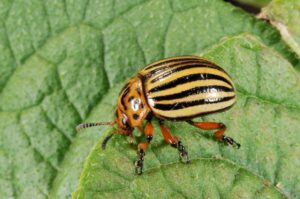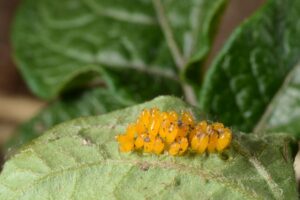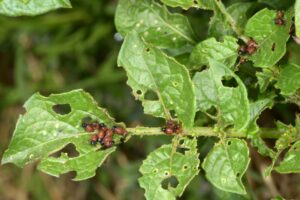At the Purdue Student Farm, we are in full swing with our Colorado Potato Beetle (CPB; Figure 1) management program.
On this small farm, these beetles are a consistent threat to the potato crop. This is in part due to their limited ability to rotate, as the whole farm is smaller than the recommended rotation distance (ranging from 200 yards to a few miles). To minimize their damage, we keep a close eye on the crop. Our initial scouting is concentrated on the field edge adjacent to the previous year’s production, as this is often the source of the overwintering population that marches across the farm to find the new crop. The main threat from this overwintering generation is the eggs (Figure 2) that they are going to be laying in the new crop. Scouting is focused on the underside of the leaves.
Potatoes were planted at the Purdue Student Farm on 4/13/2023. The plants began to emerge around 5/8/2023. The first beetles were identified in the field May 11-12, and the first insecticide application was applied on May 19th as egg clusters were widespread throughout the field; hatching had begun by May 16th in a few instances. The very first few flowers began showing on 5/30/2023.
Once again, this year, we will be evaluating five different spray programs that will be utilizing a variety of organic products. The active ingredients being evaluated include spinosad, Beauveria bassiana, Isaria fumurosa, pyrethrins and azadirachtin. These products will be used in various rotations, displayed in the table below.
| App. 1 | App. 2 | App. 3 | App. 4 | App.5 | App. 6 | |
| Program 1 | spinosad | B. bassiana | pyrethrin + azadirachtin | B. bassiana | B. bassiana | |
| Program 2 | spinosad | I. fumosorosea | spinosad | I. fumosorosea | I. fumosorosea | |
| Program 3 | B. bassiana | Pyrethrin + azadirachti | spinosad | B. bassiana | B. bassiana | |
| Program 4 | pyrethrins | B. bassiana | B. bassiana | pyrethrin + azadirachtin | pyrethrins | pyrethrins |
| Program 5 | I. fumosorosea | pyrethrin + azadirachtin | I. fumosorosea | pyrethrin + azadirachtin | I. fumosorosea | pyrethrin + azadirachtin |
The most effective organic product has proven to be spinosad. To maintain the efficacy of this product, we are interested in identifying the best time to spray it and the best ingredients to use in rotation, if multiple applications are warranted.
So, how do we determine when to spray? Some of the products we are including in this trial have a relatively slow action time (i.e. they take time to infect the host or delay host development from one stage to the next); therefore, we want to get them out on the crop when the beetle nymphs are just hatching. Before and after flowering, potatoes can experience as much as 30% defoliation before impacting tuber development. During flowering, they cannot tolerate more than 6-8% damage.
The spinosad product acts quickly to kill the pest, and therefore, applications can be made close to the threshold. However, the azadirachtin, Isaria and Beauveria take time so applications will be made weekly as long as larvae are present within those treatments.
There is a second flush (generation) of adults that will appear at/after flowering. We will continue scouting and make applications when the eggs from that generation begin to hatch. Control of the adults themselves is difficult with any of these products.
As the potato plants dry down, the beetle population may spill over into other solanaceous crops, often eggplant. While we have observed adults feeding on eggplant, we rarely see eggs and larvae on crops other than potato. Management of this second generation is not as important in terms of crop yield because most of the tuber development has been completed. However, this is the generation that will overwinter and impact the following year’s crop. Therefore, reducing this population will make control next year easier, so don’t let them go unchecked!
Below is an outline of potato production at the Purdue Student Farm.
- Work the ground early in the season, usually in March, to terminate the overwintering cover crop.
- Work the ground a second time to help incorporate dead plant material a couple of days before planting.
- Cut seed potato into roughly golf ball-sized pieces and let sit overnight to heal over where the potato was cut.
- The following day we use our Middle Buster (trencher) to make 8–10-inch-deep trenches.
- Our potato block is 68 ft x 100 ft, which allows space to make 14–100 ft rows and keeps plenty of space between rows to allow hilling.
- When the trenches are ready, we drop our potato pieces every 12 inches along with the granular fertilizer Sustane 8-2-4. We then cover it using a rake, then we wait!
- Once the potatoes have started growing and they poke through the soil surface, we will weed through the rows focusing on larger weeds but especially Canada thistle and any cover crop that might have survived the tilling (rye will sometimes survive if it rains enough between the two cultivations).
- When potato plants are around 12 inches above-ground, we will hill them using an adjustable disc bedder.
- Before chilling, we will apply the second and final application of Sustane 8-2-4.
- When hilling, we prefer to have a little bit of plant showing above ground but have found if buried completely, that it will not cause any issues for the plant.
- The hilling will also bury any smaller weeds that are in the row.
- Once the potatoes have grown again and are another 6+ inches above the ground, we will hill a second time.
- We will potentially then hill a third time a week or so later, but that is mostly to deal with any new weed emergence.
- Once potatoes have flowered, they will begin to die back in the field, and we mostly leave the block alone at that point. We only focus on weeding out any Canada thistle that is around.
- After the plants have died back completely, we will let the potatoes sit in the ground for a week or two letting them develop a thicker skin before harvesting.
- When we are ready to harvest, we get the middle buster out and run it as low as possible under the hills, which flips the soil over, revealing most of the potatoes.
- We will go through the soil with forks breaking up chunks, and look for potatoes that have not been turned over.
- Once harvested into bins, we store the potatoes unwashed in the closet of our wash pack and pull bins out to wash as we need them for our CSA program.
Contact Chris Adair (ctadair@purdue.edu), Purdue Student Farm Manager, if you have questions about potato production.


